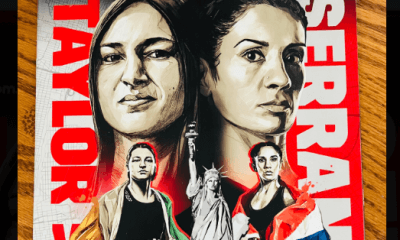Featured Articles
The Hauser Report: In Praise of Good Writing and Bart Barry

Boxing suffered a loss this week when Bart Barry announced that he was moving with his wife from San Antonio to a small town in Mexico and would no longer write his weekly column for 15rounds.com.
I met Bart at the 2009 Boxing Writers Association of America dinner in New York. Norm Frauenheim (Bart’s mentor and friend in addition to being lead boxing writer for the Arizona Republic) introduced us. Bart and I chatted again the following night at Miguel Cotto vs. Joshua Clottey at Madison Square Garden. Over time, reading his Monday morning column became a welcome start to my weekly routine.
Bart didn’t tweet “scoops” and pretend it was journalism. He didn’t report every rumor and every threat by Fighter A to kick Fighter B’s ass. Once a week for sixteen years, he wrote a column that captured the essence of boxing and the contemporary boxing scene.
Despite having a remunerative career in banking data analytics, Bart marched to his own drummer. “My wife is Mexican,” he explained this week. “Helping her build a house in the mountains of Mexico was the last goal I had. The house has now been built. I have enough money to leave the bank. By this time next week, we’ll be fully relocated to a very small, mostly indigenous town in the mountains of Mexico with no reliable electricity, no internet, and no way to watch fights.”
Will there be regrets?
“I don’t think so,” Bart told me. “Seeing the current boxing calendar makes leaving the sport easy.”
Each year, the University of Arkansas Press publishes a book with all of the articles about boxing that I wrote the previous year. In assembling the manuscript, I invariably find that I’ve quoted Bart in it. I also maintain a file with thoughts, quotes, and nuggets of information set aside for future use. Bart is well-represented there too.
Herewith, a sampler of thoughts from Bart Barry:
* ” When I began covering matches from ringside, I foolishly interpreted my press-row position as a commentary on my merits as a writer. I thought credentialing reflected something different from click-counts and a seat in auxiliary meant you were inadequate as a craftsman.”
* “There’s the pain of torn flesh or cramped muscles or wheezing breathlessness. And then there’s injury. Injury is a non-negotiable signal sent to the central nervous system. One doesn’t make his living in athletics without knowing the difference.”
* A thought experiment: Imagine Wladimir Klitschko reduced by a foot and 100 pounds and set across from a prime Juan Manuel Marquez or Manny Pacquiao. For a snicker, imagine Deontay Wilder, six inches and 60 pounds smaller and set across from Andre Ward. Then keep the mirth rolling by imagining a 112-pound man with Tyson Fury’s toolkit pitted against Roman Gonzalez. Let us have no more loose talk about today’s heavyweight prizefighters belonging on pound-for-pound lists whatever gaudy win streaks they enjoy. They are genetic lottery winners. We don’t have to call them great at boxing too.”
* “This year’s leading slugger belted forty-three home runs. In 2001, Barry Bonds hit seventy-three. That’s the difference between the natural substances and sophisticated training methods now used and steroids. And before anyone offers up a loony rebuttal that boxing trainers have discovered some secret the rest of the sports world knows nothing about, he should visit a boxing gym. Eating ice chips, rubbing one’s body with Albolene, and training in a garbage bag is the way most boxers still make weight. From such a laboratory, next year’s Nobel Laureate in chemistry is not likely to emerge.”
* “Andre Ward has approximately twice Sergey Kovalev’s craft and can fight effectively while moving in three times as many directions as Kovalev, who does incredibly well while moving forward and moving forward.”
* “Crawford enjoyed Horn’s diminishment. He felt Horn relenting and smiled. This is what makes men like Crawford exceptional. Where something like empathy for a man being stripped publicly of his dignity begins to drain others, such a stripping makes the purest fighters euphoric. It transcends professionalism: I’m not doing this because it’s my job. No, I’m doing this because I like hurting you.”
* “Deontay Wilder is a professional athlete who fights like he’s insane. Tyson Fury is an insane man who boxes conventionally.”
* “The PBC telecasts have had every ingredient imaginable. Special ringwalk music, rotating cameras, monster display boards. It’s like they’re making a cake. Flour, sugar, butter, chocolate. Wait! Here’s a chili pepper. Let’s throw that in too. The only ingredient they haven’t thrown in is good fights.”
* “Hospitalized twice for COVID since he coldcocked Whyte in their first match, Povetkin looked like he might struggle with a breathalyzer during his ringwalk and couldn’t possibly walk a straight line after a couple minutes of moving around with Whyte. Not enough is known yet about the lingering effects of COVID. But we have witnessed steep declines in prizefighters known to have contracted the virus. Boxing with perfect lungs is daunting enough. Boxing with compromised lungs? Heavens. Povetkin looked worse than nonchalant before the match. Then he went through round one with the footwork of a first-hour foal. Alexander Povetkin did not belong in a prizefighting ring.”
* “Mexican prizefighters do not wish to get struck in the face any more than any other type of prizefighter does.”
* “Moments are not memorable because someone tells you they’ll be memorable. It’s not like anyone with access to YouTube could mistake this era for a great one.”
* “Julio Cesar Chavez Jr built his following the old-fashioned way. He inherited it.”
Norm Frauenheim speaks for many in the boxing community when he says, “Bart’s a good writer and he always found a different way to look at a particular fighter or fight. It was never boilerplate, always honest. He’ll be missed. I know I’ll miss him.”
Thomas Hauser’s email address is thomashauserwriter@gmail.com. His most recent book – Staredown: Another Year Inside Boxing – was published by the University of Arkansas Press. In 2004, the Boxing Writers Association of America honored Hauser with the Nat Fleischer Award for career excellence in boxing journalism. In 2019, Hauser was selected for boxing’s highest honor – induction into the International Boxing Hall of Fame.
Check out more boxing news on video at the Boxing Channel
To comment on this story in the Fight Forum CLICK HERE
-

 Featured Articles4 weeks ago
Featured Articles4 weeks agoAvila Perspective, Chap. 330: Matchroom in New York plus the Latest on Canelo-Crawford
-

 Featured Articles3 weeks ago
Featured Articles3 weeks agoVito Mielnicki Jr Whitewashes Kamil Gardzielik Before the Home Folks in Newark
-

 Featured Articles16 hours ago
Featured Articles16 hours agoResults and Recaps from New York Where Taylor Edged Serrano Once Again
-

 Featured Articles4 weeks ago
Featured Articles4 weeks agoCatching Up with Clay Moyle Who Talks About His Massive Collection of Boxing Books
-

 Featured Articles5 days ago
Featured Articles5 days agoFrom a Sympathetic Figure to a Pariah: The Travails of Julio Cesar Chavez Jr
-

 Featured Articles3 weeks ago
Featured Articles3 weeks agoMore Medals for Hawaii’s Patricio Family at the USA Boxing Summer Festival
-

 Featured Articles7 days ago
Featured Articles7 days agoCatterall vs Eubank Ends Prematurely; Catterall Wins a Technical Decision
-

 Featured Articles4 weeks ago
Featured Articles4 weeks agoRichardson Hitchins Batters and Stops George Kambosos at Madison Square Garden




















